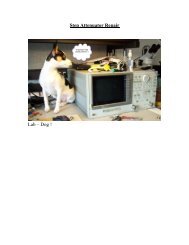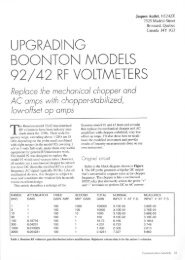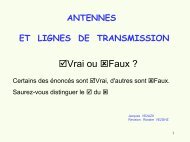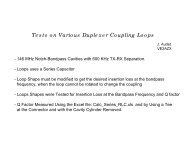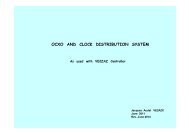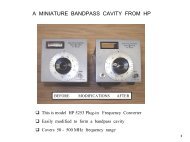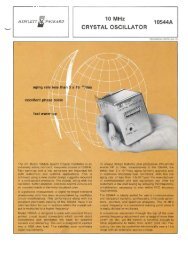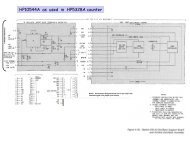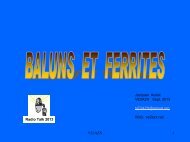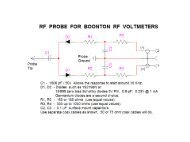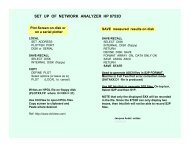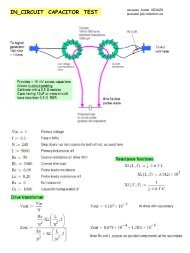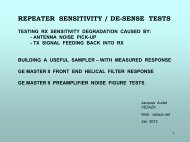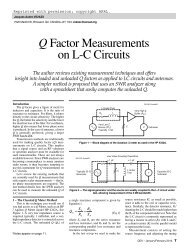Q Calculations of L-C Circuits and Transmission Lines ... - Ve2azx.net
Q Calculations of L-C Circuits and Transmission Lines ... - Ve2azx.net
Q Calculations of L-C Circuits and Transmission Lines ... - Ve2azx.net
You also want an ePaper? Increase the reach of your titles
YUMPU automatically turns print PDFs into web optimized ePapers that Google loves.
above, allows us to compute the insertion loss<br />
<strong>of</strong> a single resonator b<strong>and</strong>pass filter based<br />
on the percent b<strong>and</strong>width.<br />
100 <br />
Loss 20 log 1 (Eq 35)<br />
<br />
KQ <br />
u <br />
Equation 35 shows the relation between<br />
the unloaded Q (Q u ), K the percentage b<strong>and</strong>width<br />
(ratio <strong>of</strong> b<strong>and</strong>width to center frequency<br />
in %) <strong>and</strong> the resonator losses in dB. 8 For<br />
instance, a 2% b<strong>and</strong>width with a Q u <strong>of</strong> 200<br />
will give an insertion loss <strong>of</strong> 2.5 dB.<br />
Q Factor <strong>of</strong> Antennas<br />
Equations 9 (for open circuit antennas) <strong>and</strong><br />
14 (for closed loop antennas) may also be used<br />
to calculate the Q factor <strong>of</strong> antennas, based on<br />
their impedance data. I have provided a<br />
Mathcad file that does impedance calculations<br />
on a monopole for various lengths. 7, 9 The<br />
monopole is treated as a transmission line<br />
whose average impedance Z a is given by:<br />
Z a = 60 ln (hd) (Eq 36)<br />
where hd is the length-to-radius ratio. Here,<br />
the radiation resistance is proportional to the<br />
frequency to the power 1.7. It is added to the<br />
conductor losses.<br />
Figure 14 gives the simulated monopole<br />
Q factor. Once the Q factor is known, the<br />
b<strong>and</strong>width, BW, may be easily calculated<br />
using Equation 37. The b<strong>and</strong>width obtained<br />
gives the frequencies where the impedance<br />
phase angle is ±45°.<br />
BW<br />
f<br />
r<br />
(Eq 37)<br />
Q<br />
where f r is the center frequency.<br />
This b<strong>and</strong>width, as calculated from the Q<br />
factor, corresponds to the 7 dB return loss<br />
points or to an SWR <strong>of</strong> ~2.62. For a 2:1 SWR,<br />
the b<strong>and</strong>width is 70% <strong>of</strong> the above. This assumes<br />
that the SWR is 1:1 at resonance.<br />
Conclusion<br />
In this paper I have shown that a single<br />
general equation may be used to calculate<br />
the Q factor <strong>of</strong> RLC circuits <strong>and</strong> transmission<br />
lines as it relates to circuit selectivity. I<br />
have shown that series resonances are taken<br />
care by Equation 9 while Equation 14 takes<br />
care <strong>of</strong> parallel resonances. The difference<br />
between the two is the use <strong>of</strong> impedances for<br />
the first <strong>and</strong> admittances for the second equation.<br />
By using the provided Mathcad files <strong>and</strong><br />
the associated public domain programs, it is<br />
easy to compute the Q factor <strong>of</strong> coaxial <strong>and</strong><br />
microstrip or stripline resonators for any<br />
length <strong>and</strong> frequency. The calculated Q factor<br />
agrees very well with the measured data<br />
<strong>and</strong> with the Q values computed by the impedance<br />
measurement method. When simulating<br />
stub resonators, it is very important that<br />
the full R L G C transmission line models be<br />
used. The Mathcad files show how to optimize<br />
the Q factor <strong>of</strong> PCB microstrip <strong>and</strong><br />
stripline resonators. The same files also show<br />
the calculations <strong>of</strong> R L C G functions <strong>and</strong><br />
coefficients to be incorporated into any RF<br />
simulation s<strong>of</strong>tware. It is interesting to note<br />
that these four frequency dependent parameters<br />
fully describe the transmission line. I<br />
found that the Q values predicted from Equations<br />
9 <strong>and</strong> 14 fully agree with the values<br />
obtained in the simulation s<strong>of</strong>tware.<br />
The simulations presented here show that it is<br />
possible to get higher Q factors on low-loss lines<br />
by using higher-order modes, such as ¾ λ. For<br />
PCB resonator traces, the optimum Q is generally<br />
below a quarter wavelength.<br />
Note that the models presented here do<br />
not take into account the radiation losses <strong>and</strong><br />
surface roughness <strong>of</strong> microstrips. The line dc<br />
resistance has been included in the PCB line<br />
models, since its contribution is not negligible<br />
at narrow trace widths. For coaxial<br />
lines, the dc resistance has been omitted to<br />
keep the models simpler <strong>and</strong> relieve the user<br />
from searching for the resistance data. This<br />
makes the coaxial models less accurate below<br />
approximately 5 MHz. The dc resistance<br />
may be added to the ac conductor resistance<br />
by taking the square root <strong>of</strong> the sum <strong>of</strong> the<br />
squares <strong>of</strong> the dc <strong>and</strong> ac resistances, as done<br />
in the file: TRL_Q_Calc-PCB1.mcd.<br />
Thanks to Chase Hearn <strong>and</strong> Yan Gunmar<br />
for triggering this study <strong>and</strong> providing<br />
various helpful references <strong>and</strong> comments.<br />
Appendix<br />
An intuitive view <strong>of</strong> the general function<br />
for calculating the Q factor is derived here.<br />
The general equation for computing the<br />
Q factor <strong>of</strong> RLC circuits, transmission line<br />
resonators <strong>and</strong> antennas operating in the series<br />
resonant mode is given by the source at<br />
Note 1. This equation is valid from low frequencies,<br />
though series resonance <strong>and</strong> for<br />
frequencies much above series resonance.<br />
X<br />
Q <br />
<br />
dX<br />
<br />
<br />
<br />
2 R d<br />
<br />
(Eq A1)<br />
<br />
Where ω = 2π f, the radian frequency, R<br />
<strong>and</strong> X are respectively the real <strong>and</strong> imaginary<br />
parts <strong>of</strong> the impedance .<br />
Equation A1 may be written in terms <strong>of</strong><br />
the frequency:<br />
f <br />
dX X <br />
Q <br />
<br />
2 R df f <br />
<br />
(Eq A2)<br />
Figure 13 — Measured Q factor <strong>of</strong> an open line. Computed Q<br />
factor versus frequency (solid lines, from impedance<br />
measurements) for a 100 inch length <strong>of</strong> RG-58, giving first<br />
resonance at ~19.4 MHz. Compare these to simulations in Figures<br />
3 <strong>and</strong> 4. The dotted lines show the apparent Q.<br />
Figure 14 — Monopole Q factor (solid curve) as calculated from<br />
the Mathcad file: Monopole-Ralph.mcd. The quarter wave<br />
resonance is at 6 MHz, as shown by the dotted line curve<br />
(apparent Q) which was calculated from the reactance to<br />
resistance ratio. Note the steep increase in Q as the frequency is<br />
lowered. This comes from the fact that the radiation resistance<br />
decreases approximately as frequency to the power 1.7. At 1 MHz<br />
<strong>and</strong> below we have a low-loss air insulated capacitor!<br />
50 Sep/Oct 2006



